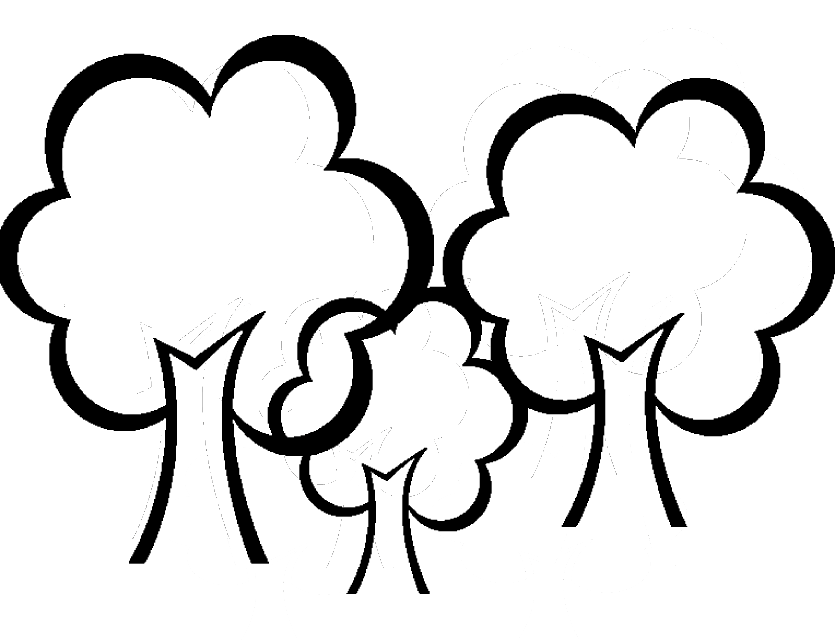Invalid tree work notifications and applications
For advice about all aspects of tree work applications and notifications please go to gov.uk Tree Preservation Orders and trees in conservation areas (formerly known as the Blue Book).
For advice about filling out the application form there is a guidance note available from the Planning Portal.
The Forestry Commission manages felling licences. The felling licence application requires you to say if the tree or trees are in a Conservation Area or are the subject of a Tree Preservation Order (TPO). The Commission will contact us directly about any applications which are covered by conservation areas or TPO – you do not need to submit a separate application to us.
Jump to:
- Conservation area notices minimum threshold
- TPO applications minimum threshold
- Name of the applicant/person who submitted it
- Address of the land where the tree stands
- Tree location plans
- Photographing application trees
- Tree work proposals
- Identifying the tree
- Proposing tree work
- TPO applications - reasons for tree work
- TPO applications - damage to buildings (subsidence)
- TPO applications - damage to light structures
Conservation area notices minimum threshold for what?:
- date of the notice
- the name of the applicant/person who submitted it
- the address of the land where the tree stands
- the proposed work clearly specified
- a tree location plan
TPO applications minimum threshold for what?:
- on the application form
- agent, tree owner and applicant completed as necessary
- a clear plan identifying application tree(s)
- clearly specify the tree work,
- reasons for the tree work
- provide evidence, as necessary
Name of the applicant/person who submitted it
The applicant tends to be the person paying for the tree work, often the tree owner.
The agent is most often the tree surgeon, estate manager, solicitor or other advisor who is managing or overseeing the application.
If the applicant would be concerned or unhappy about publishing their name to the internet in association with an address because they are a household name or have an unusual name please speak to them about this before submitting the application/ notification.
Address of the land where the tree stands
If the trees grow on more than one property, or if the trunk straddles the boundary between two properties, you should enter the details of the second address. There is space at the bottom of the question to add additional addresses.
If the tree does not stand in a property you can use a description. Examples are:
- land at Cambridge Lane, north of house 101
- land between 99 and 101 Cambridge Lane
- land to the rear of 101 Cambridge Lane
- land at Cambridge Lane, access near 40mph sign
We strongly advise you to use additional forms if the tree work schedule is complex and covers many properties.
Tree location plans
Sketch plans should be readable and clear. Showing property boundaries and adjoining properties (including house names or numbers) and names of roads is helpful. Showing other trees in the garden can be helpful, even if they are not being worked on. Below is an example of a good sketch plan.
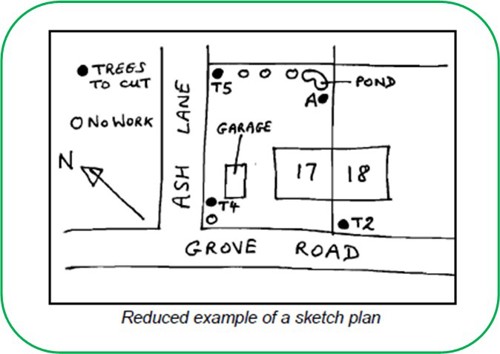
A scaled plan is not necessary.
A copy of a property plan or aerial photograph is acceptable, provided the specific tree(s) can be identified on site.
If the trees cannot be clearly identified on a plan because they are part of a woodland or group, identify their approximate location on the plan and explain how the tree(s) have been marked on site (for example, tiger tape, tree tags, tree paint). Do not scribe (cutting into the bark) the tree(s).
Below are examples of poor sketch plans.
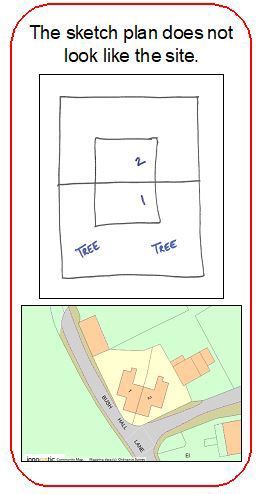
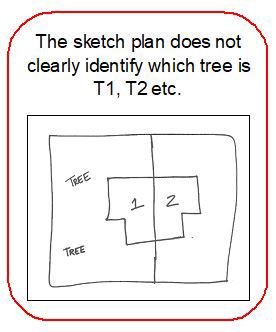
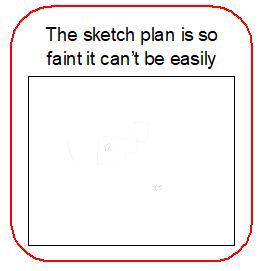
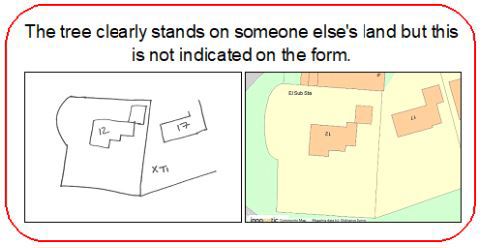
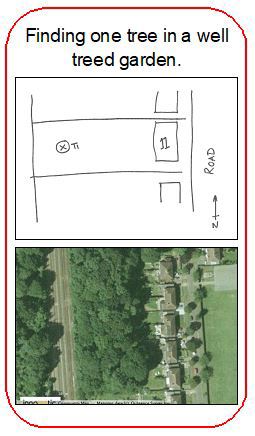
Photographing application trees
Photographs are useful, particularly where you wish to identify the trees you want to work on to show specific work where there could be doubt. For example, marking a specific branch to be trimmed.
Clearly identify the tree in question using tiger tape, tree paint or using a clearly visible prop such as a colourful clipboard.
Tree work proposals
The most efficient proposals are: 'Tree reference a species to type of work by amount'.
Examples are:
- T1 a lime to crown lift to 3m and crown reduce by 2m.
- G4 conifer hedgerow to remove.
- O1 Oak to crown reduce by 3m (from a radius of 9m to 6m).
The reference must match the tree location plan.
Note well: information in this section is published to our website and inserted on neighbour and parish notifications with no editing. Please do not put information which may be sensitive into this section. For example: arguments between neighbours, phone numbers or emails.
Identifying the tree
Give the species if known, for example, oak or pine. Scientific names are not necessary.
If the tree is difficult to identify and there are multiple trees in the garden, we strongly advise you to take a photograph of the tree and submit it.
Proposing tree work
The proposed tree works must be clearly specified. Terms such as top, lop, cut down are not acceptable. The current best practice can be found in BS3998:2010 Tree work – Recommendations. We've listed the most popular terms below.
Formative pruning
This is a collective or general term for using combinations of pruning types to produce a tree which in maturity will be free from any major physical weakness and which will complement the management objectives of the site. Only use it when clearly identifying what formative pruning represents to the individual tree.
Crown thinning
The percentage of the leaf-bearing twig structure to be removed should be stated. It is helpful to indicate the maximum diameter of pruning wound to be created. For example: 'T1 a lime to crown thin by 20% (pruning wounds no larger than 3cm diameter)'.
Crown lifting
Specify the distance between the clearance points. For example: ‘T2 Oak to crown lift to 2.5m over footpath’, ‘T3 Ash to crown lift 1m over roof level’ or ‘T4 Pine to crown lift 4m above ground level’.
Crown reduction and reshaping
The specification should be accurate and clear, so that the desired result is achieved. To avoid ambiguity, the specified end result can either be stated as the tree-height and branch-spread which are to remain, or the average equivalent in branch length (in metres). End results should be specified for individual branches if the growth pattern of the tree creates a need for this, or where clearance from a specific object is required. It is helpful to state either current tree dimensions or the radial distance to be removed. For example, ‘T5 London plane to crown reduce by 2m (to leave a tree 15m in height and 6m in radius)'.
Selective pruning or clearance from objects
If individual branches need to be shortened to removed so as to increase horizontal or vertical clearance from another feature, the proposal should state the feature and the clearance to be achieved. For example, ‘T8 Beech to trim back branches around lamp post to clear by 1m’ or ‘G9 Purple leaved plums to trim off phone lines to clear by 0.5m’.
Pollarding or reduce back to previous pruning points
If there are multiple pollarding points on the tree, indicate which pollard point is being utilised. The assumption is that the pruning point will retain the pollard knuckle. If the cuts are to be made below the knuckles, please state this (and explain the reasoning).
The following terms and phrases are indecisive and should be avoided:
- "option 1 and/or option 2"
- "either / or"
- "we are suggesting…"
The following do not specify the type of pruning or quantity to be undertaken and should be avoided:
- crown by
- crown clean
- crown clean deficient branches
- crown reduce by about 20%
- formative prune (without additional explanation)
- light prune
- minor crown lift/prune
- prune carefully
- prune to shape
- reduce by
- repollard near previous pruning points
- sympathetically prune
TPO applications - reasons for tree work
Reasons must be given for pruning trees TPO trees. Some reasoning will require significant amounts of evidence to support the case for the pruning such as structural damage – see damage to buildings (subsidence) or damage to light structures.
The presence and impact of pests, diseases or fungi that require work to be carried out to the tree(s) should be described. Providing photographs of these can be helpful.
If the tree has defects that may be of concern to the current or future safe retention of the tree or parts of the tree, please identify and quantify them. For example, the location and size of decay cavities (and the remaining sound wood) can be very helpful.
TPO applications - damage to buildings (subsidence)
Reports will usually be provided by a structural engineer and/or a chartered surveyor and be supported by technical analysis from other experts. For example, for root and soil analysis. These reports must include the following information:
- a description of the property, including a description of the damage and the crack pattern, the date that the damage first occurred/was noted, details of any previous underpinning or building work, the geological strata for the site identified from the geological map
- details of vegetation in the vicinity and its management since discovery of the damage. Including a plan showing the vegetation and affected building
- measurement of the extent and disruption of vertical movement using level monitoring. Where level monitoring is not possible, state why and provide crack monitoring data. Data provided must be sufficient to show a pattern of movement consistent with the presence of the implicated tree(s)
- a profile of a trial/borehole dug to identify foundation type and depth and soil characteristics
- the sub-soil characteristics including soil type (particularly that on which the foundations rest), liquid limit, plastic limit and plasticity index
- the location and identification of roots found. Where identification is inconclusive, DNA testing should be carried out
- proposals and estimated costs of options to repair the damage.
In addition, you must include a report from an arboriculturist to support the tree work proposals, including arboricultural options for avoidance or remediation of indirect tree related damage.
TPO applications - damage to light structures
Technical evidence in respect of other types of structural damage (e.g. garden walls, drains, paving, drive surfaces) should be provided by a relevant engineer, building/drainage surveyor or other appropriate expert.

